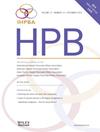微创与开放肝切除术治疗分期BCLC - B和- C的非转移性肝细胞癌:意大利多中心分析。
IF 2.4
3区 医学
Q2 GASTROENTEROLOGY & HEPATOLOGY
引用次数: 0
摘要
背景:最近的论文报道了BCLC-B和-C HCC患者肝切除术后生存率的显著提高。微创肝手术(MILS)治疗此类患者的结果迄今尚未得到广泛研究。方法:从HERCOLES数据库中提取HCC分期BCLC -B和-C患者行mls或开放肝切除术(OLR)的数据。采用处理加权逆概率法(IPTW)来平衡混杂因素。主要终点是一个复合终点,包括肝切除术后肝衰竭、严重术后并发症和住院死亡率。结果:纳入627例患者,其中459例接受OLR, 168例接受MILS。IPTW后,MILS和OLR的综合终点无差异(OR 0.86 [95%CI 0.46-1-60];P = 0.62)。MILS降低了术中输血的风险(OR 0.28 [95%CI 0.13-0.58];p < 0.001)和术后腹水发生率(OR 0.56 [95%CI 0,32-0,98];p = 0.039),住院时间缩短(OR 0.82 [95%CI 0.66-1.01];P = 0.045)。生存分析显示,对于OS (p = 0.13)和DFS (p = 0.491), MILS和OLR之间没有差异。结论:对于部分BCLC B期和C期非转移性HCC患者,MILS是安全可行的,可降低围手术期输血和术后腹水的风险,缩短住院时间。本文章由计算机程序翻译,如有差异,请以英文原文为准。
Minimally invasive versus open liver resection for nonmetastatic hepatocellular carcinoma staged BCLC – B and – C: an Italian multicentric analysis
Background
Recent papers report significant survival gain after liver resection in BCLC-B and -C HCC patients. The results of minimally invasive liver surgery (MILS) in such patients have not been widely investigated so far.
Methods
Data regarding patients undergoing MILS or open liver resection (OLR) for HCC staged BCLC -B and -C were extracted from the HERCOLES database. An inverse probability of treatment weighting (IPTW) method was adopted to balance the confounders. The primary outcome was a composite endpoint including post-hepatectomy liver failure, severe postoperative complications and in-hospital mortality.
Results
627 patients were included (459 undergoing OLR and 168 receiving MILS). After IPTW, no difference was found in the composite endpoint between MILS and OLR (OR 0.86 [95%CI 0.46-1-60]; p = 0.62). MILS reduced the risk of receiving intra-operative transfusions (OR 0.28 [95%CI 0.13-0.58]; p < 0.001) and of developing postoperative ascites (OR 0.56 [95%CI 0,32-0,98]; p = 0.039), with reduced length of stay (OR 0.82 [95%CI 0.66-1.01]; p = 0.045). The survival analysis showed no differences between MILS and OLR for both OS (p = 0.13) and DFS (p = 0.491).
Conclusion
MILS was shown to be safe and feasible for selected non-metastatic HCC patients staged BCLC B and C, reducing the risk of perioperative transfusions and postoperative ascites, and shortening the length of stay.
求助全文
通过发布文献求助,成功后即可免费获取论文全文。
去求助
来源期刊

Hpb
GASTROENTEROLOGY & HEPATOLOGY-SURGERY
CiteScore
5.60
自引率
3.40%
发文量
244
审稿时长
57 days
期刊介绍:
HPB is an international forum for clinical, scientific and educational communication.
Twelve issues a year bring the reader leading articles, expert reviews, original articles, images, editorials, and reader correspondence encompassing all aspects of benign and malignant hepatobiliary disease and its management. HPB features relevant aspects of clinical and translational research and practice.
Specific areas of interest include HPB diseases encountered globally by clinical practitioners in this specialist field of gastrointestinal surgery. The journal addresses the challenges faced in the management of cancer involving the liver, biliary system and pancreas. While surgical oncology represents a large part of HPB practice, submission of manuscripts relating to liver and pancreas transplantation, the treatment of benign conditions such as acute and chronic pancreatitis, and those relating to hepatobiliary infection and inflammation are also welcomed. There will be a focus on developing a multidisciplinary approach to diagnosis and treatment with endoscopic and laparoscopic approaches, radiological interventions and surgical techniques being strongly represented. HPB welcomes submission of manuscripts in all these areas and in scientific focused research that has clear clinical relevance to HPB surgical practice.
HPB aims to help its readers - surgeons, physicians, radiologists and basic scientists - to develop their knowledge and practice. HPB will be of interest to specialists involved in the management of hepatobiliary and pancreatic disease however will also inform those working in related fields.
Abstracted and Indexed in:
MEDLINE®
EMBASE
PubMed
Science Citation Index Expanded
Academic Search (EBSCO)
HPB is owned by the International Hepato-Pancreato-Biliary Association (IHPBA) and is also the official Journal of the American Hepato-Pancreato-Biliary Association (AHPBA), the Asian-Pacific Hepato Pancreatic Biliary Association (A-PHPBA) and the European-African Hepato-Pancreatic Biliary Association (E-AHPBA).
 求助内容:
求助内容: 应助结果提醒方式:
应助结果提醒方式:


